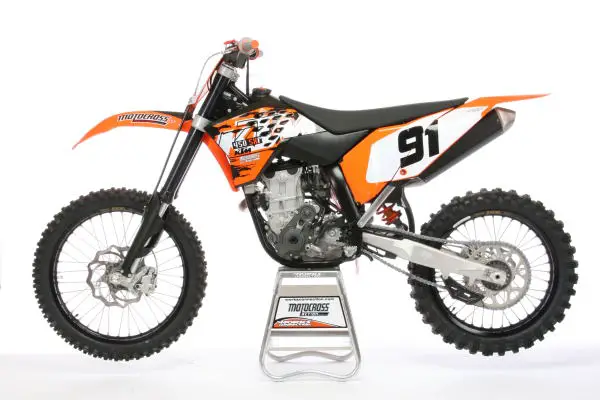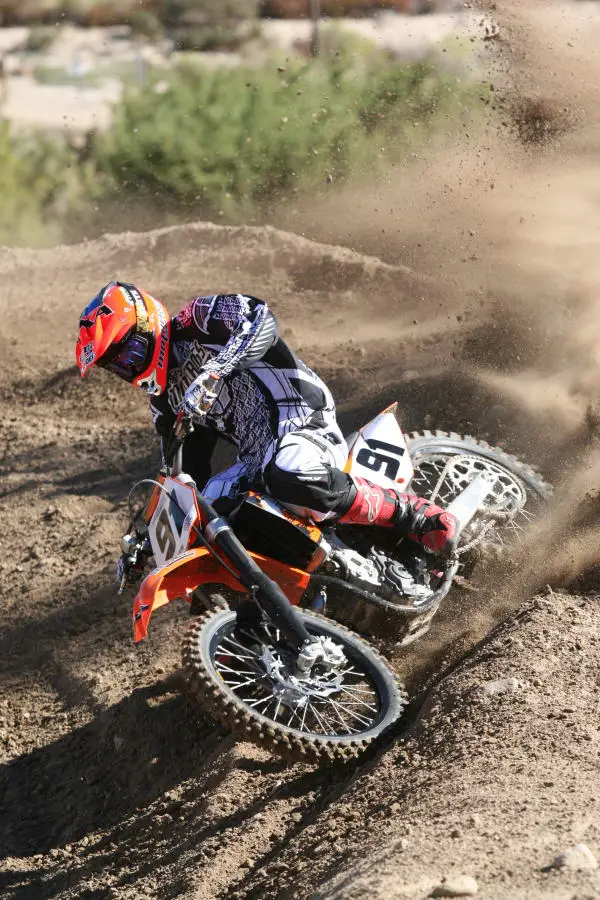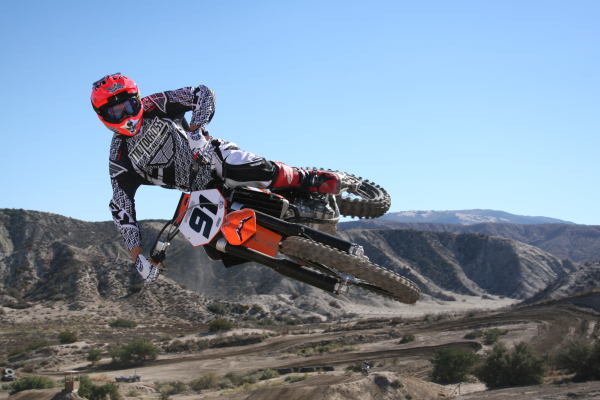2008 RACE TEST: KTM 450SXF
KTM is the Rodney Dangerfield of American motocross. They get no respect. In sheer numbers, there are fewer KTMs on the starting lines than any of the other Big Five brands. In the psyche of American riders, KTMs are considered to be offbeat, unusual and different. When it comes time to plunk down cold hard cash for a race bike, KTM is rarely the first choice on the consumer’s wish list.
The strange thing about KTM’s perceived position in the motocross world is that their status in European motocross and American off-road racing is the polar opposite. In those environs, KTMs pack the starting lines, are dream machines, and are number one on the wish list.
KTM has pondered this unique dichotomy for years. What makes them a smash hit in one sphere of motorcycling and a hard sell in another? If KTM could solve that riddle, their motocross machines would get the attention they deserve. The question for 2008 is whether or not the KTM 450SXF has cracked the code. That is what the MXA wrecking crew set out to discover.
Q:IS THE 2008 450SXF FASTER THAN THE 2007 450SXF?
A:Yes. We are talking about a two horsepower gain at peak, as much as three horsepower at 9000 rpm, and an extra horse off idle. This is a 450cc motocross engine that has gained almost six horsepower in three years. Yikes!
Q:HOW STRONG IS THE 2008 KTM 450SXF ON THE DYNO?
A:On the dyno, it is the most powerful 450 motocross bike on the showroom floors. Peaking out at 54.3 horsepower, the 2008 KTM 450SXF is two horsepower stronger than the CRF450 and four ponies up on the KX450F and YZ450F.
In 2008, KTM is the only company playing the horsepower card. Every other 2008 bike that the MXA wrecking crew has tested has given up peak horsepower in search of a more manageable powerband. KTM, on the other hand, went for the gusto.
Q:IS THE HORSEPOWER KING STILL MANAGEABLE?

A:Indubitably so. KTM deserves all the respect in the world for the powerband on the 2008 450SXF. Even though the Austrian mill is the horsepower king of the 450 class, it was easy to ride. We loved this engine. Why? It didn’t knock your socks off or scare you with John Force-style acceleration. The powerband is deceptive. It builds the power in a crescendo, like the roll of a bass drum. It starts out slow and steady, increasing its tempo as the rpm climbs, finally going over the top in a blur of crashing cymbals.
If you just went out on the track and cruised, you would think the 2008 KTM 450SXF was slow. It’s so mellow below 7000 rpm that you’d be hard-pressed to believe that this was the most powerful bike on the track. That’s because it is the third most powerful bike on the track below 6500 rpm, but from there on up it starts to romp.
Q:HOW GOOD IS THE 2008 KTM 450SXF’S POWERBAND?
A:It’s great. The caveat to the greatness is that you have to understand the unusual mix of vibes that makes this powerband work.
First, if this were a two-stroke, it would be a mid-and-up engine. It does its best work after 7500 rpm. It has the most top-end power. The most overrev. The highest rev limiter. And the longest pull.
Second, this isn’t a two-stroke engine. It is a big, powerful and torquey four-stroke. And the fact that its powerband is higher on the scale than the CRF, YZ-F or KX-F would only be an indictment if the KTM came on like a screaming banshee at 7500 rpm and drained the blood from your eyeballs. Not so. The mellow bottom end is point/counterpoint to the impressive top end. Thanks to the pleasantness of the low end, and its seamless transition, KTM has built a high-horsepower engine that is still controllable?proving that you don’t have to give up the ponies in search of rideability.
Third, of all the 2008 engines, the KTM is the least intimidating to ride. Ain’t’ that a kick in the pants? The most powerful bike is the most pleasant bike. It’s a raging bull with manners.
Q:ARE THERE ANY CONUNDRUMS TO THE KTM 450SXF POWERBAND?
A:Yes. Gearing is an issue. The four-speed gear box has very tall ratios. In fact, the 2007 and 2008 trannies got a primary gear that made the ratios so much taller in first gear that first gear was identical to second gear back in 2006.
The problem (and it’s not so much a problem as an opportunity) with KTM’s tall gear ratios is that this is a bike without a first gear. On the track, first gear feels like second gear. And, when you combine that initial tall gear ratio with the broadness of the KTM’s powerband (remember, this bike produces a linear-style of power that seems almost endless), you find yourself racing around a large portion of the track in one gear. There is nothing wrong with that, except that when everyone else is talking about jumping the fourth-gear double, a KTM rider has to bite his tongue rather than admit that he is doing it in second gear.
The combination of abundant horsepower and four widely spaced gears means that the MXA test riders shifted the 450SXF about half as often as a CRF, RM-Z, YZ-F or KX-F. Depending on your track, speed and tastes, you could easily add one tooth to the rear sprocket to punch up the low-end power, tighten up the gear ratios and get into second and third more often. Conversely, there were slower test riders who wanted to gear it taller (one tooth less on the rear) in hopes that they would never have to shift again.
Q:IS THE FOUR-SPEED BETTER THAN A FIVE-SPEED?
A:American racers prefer five speeds over four. That’s a fact. Five sounds faster than four. In the land of opportunity, five gives you more options (to do it right and to do it wrong). That said, the ultimate goal of a big-bore four-stroke engine is to produce enough torque and horsepower that shifting becomes less necessary. Tim Ferry is a big advocate of the less-is-more concept. When he was at Team Yamaha, he raced a three-speed works bike, and at his current home he uses a four-speed in his KX450F.
Do we think that KTM needs a five-speed tranny? Paradoxically, we think that they need to go to five speeds to win over a skeptical American public, but that their four-speed is the right way to go for their power profile.
Q:WHAT ARE THE PLUSES AND MINUSES OF THE ELECTRIC STARTER?
A:The minus is that the 450SXF is the heaviest of the Big Five 450s (thanks to the battery, starter motor and extra gear). The plus is that you never have to kick it over. Press the button and go. Is the electric starter worth the extra eight pounds? You bet. Most riders live in fear of their bikes not starting. Many refuse to turn them off on the starting line for fear that they won’t re-light. Not KTM riders.
Q:HOW IS THE JETTING?
A:KTM uses the simplest Keihin FCR carb possible. It doesn’t even come with a leak jet. Simple seems to work. Apart from pilot and fuel screw adjustments, we were happy as clams with the Keihin/KTM partnership.
MXA’s recommended jetting is as follows:
Main: 182
Pilot: 40
Needle: OBDCP
Clip position: Fourth from top
Fuel screw: 1-3/4 turns (1-1/2 turns stock)
Notes: In summer you can get away with the stock 40 pilot, as long as you adjust the fuel screw for the ambient temperature, but come winter you are going to need a 42.
Q:WHAT ARE THE DIFFERENCES BETWEEN THE DUAL-IGNITION CURVES?
A:We stuck with the stock curve but liked the idea that we could change the powerband to a slightly torquier feel by unplugging one wire. KTM’s marketing department is missing the boat on dual-ignition by not putting a switch on the handlebars. Substance isn’t so readily apparent without a little flash.
Q:WHAT DID KTM DO TO THE SUSPENSION FOR 2008?
A:They did exactly what the MXA wrecking crew asked them to do. Last year’s suspension was undersprung. It was too soft, which made it feel too stiff, and the whole wallowing kit-and-kaboodle was a nightmare. Thankfully, KTM upped the springs, front and rear, for 2008. Last year’s 6.6 kg/mm shock spring is now a 6.9 and the 0.46 kg/mm fork springs have been replaced with 0.48s. Additionally, the forks get low-stiction seals, bushings and bearings.
Q:IS THE SUSPENSION BETTER THAN LAST YEAR?
A:Maybe, and maybe not. The stiffer springs are a big plus, but the WP engineers didn’t complete the renovations. Last year, MXA ran a combination of stiffer fork springs and a lower oil height. We found that the stiffer springs held the front end higher in its stroke, while the larger air cavity reduced midstroke harshness. To us, it was the logical path to follow. WP only bought into half of our equation?to our regret. In our opinion, WP gave up a golden opportunity to fix their forks and instead made a series of changes that resulted in zip-squat-zero improvement in the forks. Just like the 2008 Honda CRF forks, the KTM forks are so harsh in the midstroke that they jolt your shoulders when they abruptly stop moving. We disliked the WP forks as much in 2008 as we did in 2007.
Q:WHAT IS THE BEST FIX FOR THE 2008 KTM FORKS?
A:Our quick fix was to lower the oil height by 20cc. Lowering the oil height lessened the midstroke spike and gave us the opportunity to add or subtract small quantities of oil to suit track conditions.
Q:WHAT WAS OUR BEST FORK SETTING?
A:For hard-core racing we recommend this fork setup on the 2008 KTM 450SXF:
Spring rate: 0.48 kg/mm
Oil height: 370cc (390cc stock)
Compression: 18 clicks out
Rebound: 19 clicks out
Fork leg height: 5mm up
Note: KTM claims to have reduced stiction in the forks, but compared to Showa or Kayaba forks, our WP forks had a lot of static friction.
Q:HOW GOOD IS THE REAR SUSPENSION ON THE 2008 KTM 450SXF?
A:KTM’s no-link rear suspension is a public relations nightmare. Scientifically, it can be proven that the rising rate of a single-sided, linkless shock is identical to that of a revolving link system, but the average consumer doesn’t buy it. Science or not, they believe that the lack of linkage means that the KTM doesn’t have a rising-rate leverage curve. Wrong! The problem is that KTM has made a mess of their linkless rear suspension. They have selected bad rising rate curves (based on the location of the shock) and hinged their success on the Ohlins-designed PDS dual-piston shock design (which probably wasn’t the proper design for their system). Unfortunately, they have stubbornly stuck to their guns in the face of an angry mob.
In our opinion, the rear of the KTM stills faces the quandary of how to be supple over small bumps without moving too quickly through big hits (or vice versa). The stiffer shock spring helps, but setup is crucial to getting the most out of the rear shock. Too soft and it will wallow; too stiff and it will kick. There are numbers on the shock that will work, but they have to be found through analytical pursuit?something that motocross racers are not famous for.
Q:WHAT WAS OUR BEST SHOCK SETTING?
A:For hard-core racing we recommend this shock setup for the 2008 KTM 450SXF:
Spring rate: 6.9 kg/mm
Race sag: 110mm
High-compression: 1-1/2 turn out
Low-compression: 15 clicks
Rebound: 24 clicks
Notes: If you are very fast or very fat, the 6.9 shock spring will not be stiff enough for you to get the correct race sag (and still have free play in the shock). No free play will result in a shock that kicks like an Army mule. KTM’s optional heavier spring is a 7.2 kg/mm.
Q:HOW DOES IT HANDLE?
A:KTM’s traditional understeer is a thing of the past. With some fiddling with the race sag and fork height, the KTM can track an inside line with ease. Most MXA test riders wanted 105mm of sag, but the KTM felt more level at 110mm. It’s still a stinkbug chassis, but not as irritatingly so as in years past. To get it to corner to its fullest, you will need to swap the stock Bridgestone M59 for a better front tire.
Q:WHAT DID WE HATE?
A:The hate list:
(1) Black: We love black rims and black forks on the other people’s bikes, but not ours. They look like they were blasted by a shotgun after a couple months of racing.
(2) Side panels: Maybe we are wrong about the idea of being scored at motocross races. Obviously KTM doesn’t think that anybody needs to run full-size numbers.
(3) Lifting: There is no place to grab the KTM 450SXF, save for the hot exhaust or flexy fender.
(4) Forks: They are extremely harsh from the midstroke on. KTM needs to change the stock oil height spec or revalve the midstroke.
(5) Hot start lever: The plastic hot start lever is prone to damage.
(6) Seat: We’ve never felt comfortable with KTM’s foam. Your KTM dealer can get you optional saddles in every size from thick to thin.
(7) Tires: We used to think it was cool that KTM brought back the discontinued Bridgestone M59/M70 tire combo, but the world has moved on. These are good sneakers, but not great ones.
Q:WHAT DID WE LIKE?
A: The like list:
(1) Front brake. Awesome front brake. It is so strong that it rivals the brakes on works bikes.
(2) Hydraulic clutch. Every bike should have a hydraulic clutch. It takes the hassle out of fluctuating lever settings.
(4) Fork guards. KTM’s new wraparound fork guards are the most protective in the sport.
(5) Gas cap. Why would KTM put a lock on their gas cap? You have to push a button before you can turn the cap. Isn’t that like wearing suspenders to hold up your belt?
(3) Electric starter. Every R&D budget for 2009 should include electric starter technology instead of fuel injection. Modern bikes run fine with Keihin carbs, but they don’t always start. The KTM does.
Q:WHAT DO WE REALLY THINK?
A:It’s fashionable to knock KTM in the USA, but we’d like to offer them kudos instead. The small Austrian factory, an underdog when compared to the might of their Japanese competitors, has managed to build an engine that is the envy of the industry. It makes the most power, the broadest power, the highest revving power and is incredibly easy to use. Yes, Virginia, KTM still needs help on its suspension settings, but this bike is more like Charles Atlas than Rodney Dangerfield.










Comments are closed.